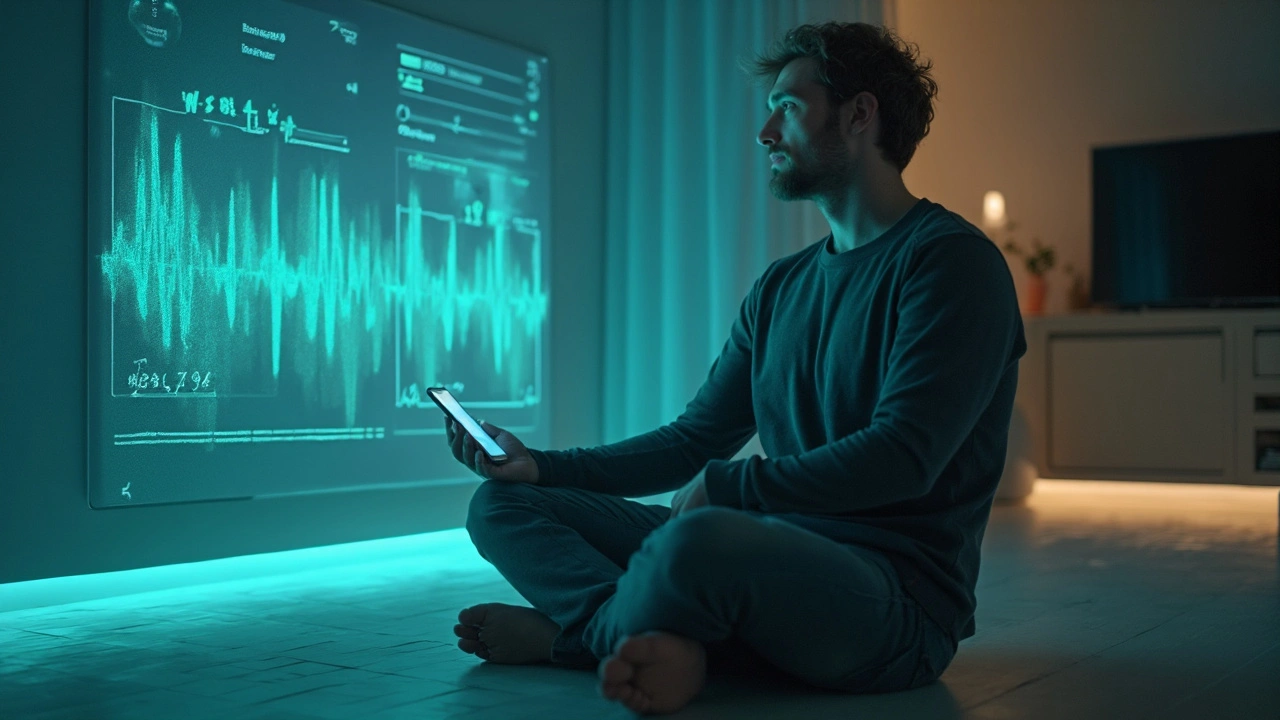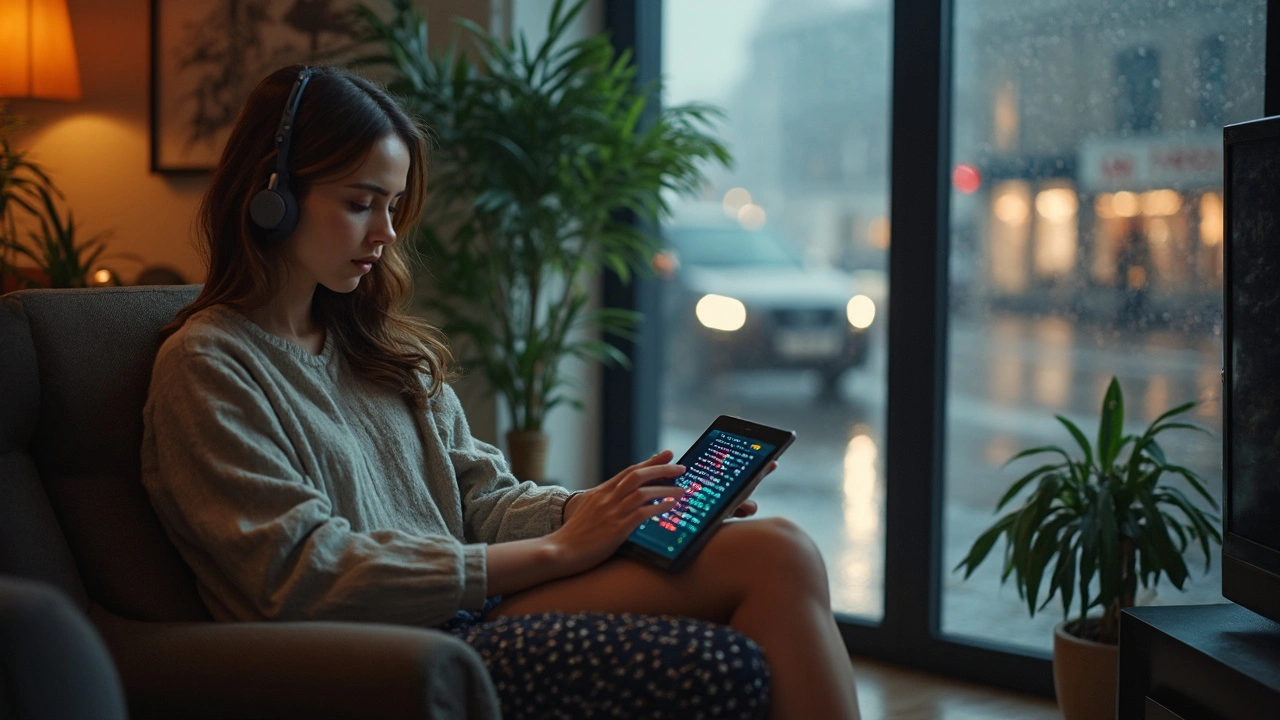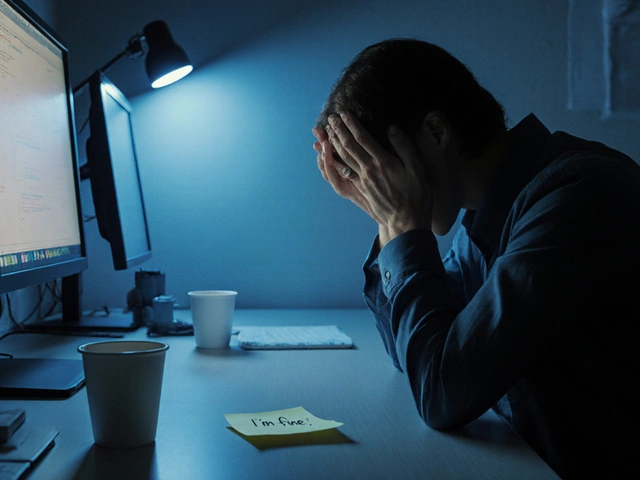Ever felt your chest tighten before an interview or your palms get sweaty in rush hour traffic? Stress makes your body react, often before your mind even registers it. That’s where biofeedback steps in. It turns what's happening inside you into something you can actually see—like your heartbeat or how tense your muscles are—on a screen right in front of you.
Instead of just guessing at how stressed you are, biofeedback uses sensors to track real signals from your body. You get live feedback, so you can literally watch your stress level shift. Try different breathing techniques or muscle exercises, and see on the screen in real time if it’s making a difference. It’s like a stress GPS that tells you when you’re headed the wrong way and when you’re back on track.
This tech isn’t just for people with anxiety issues. It’s grown super popular with anyone dealing with work overload, cranky kids, or just plain life. Even my own daughter, Phoebe, loves seeing her “brain waves” light up when she practices her calm breathing trick. You don’t need to be a yogi or a scientist—if you know how to use a remote, you’re good to go.
- How Biofeedback Keeps Tabs on Stress
- Tools and Gadgets That Make It Work
- What a Biofeedback Session Is Really Like
- Everyday Tips to Boost Stress Relief
How Biofeedback Keeps Tabs on Stress
So, what’s going on under the hood when you’re stressed? Biofeedback turns your body’s “silent alarms” into stuff you can actually measure. When people talk about biofeedback, they mean sensors hooked up to your skin, fingers, or even your head that watch things like your heart rate, skin temperature, and how fast you’re breathing.
Here’s the deal: Your body sends out stress signals way before you realize you’re frazzled. Ever notice your heart speeding up during a test, or your hands getting cold during a tense moment? That’s stress in action. Biofeedback pulls numbers from those signals and puts them right on a monitor, app, or graph, so you can see what stress looks like in real time.
- Heart Rate: Monitors show your heart pounding faster when you’re anxious. Learning to slow it down tells your brain it’s time to chill out.
- Muscle Tension: Little sensors (often placed on your forehead or shoulders) spot when your muscles tighten up. You might not feel it, but the device will pick up even tiny changes.
- Skin Temperature: Stress can make fingers and toes cold. Biofeedback devices can show how your blood flow changes, so you know when you’re getting worked up.
- Breathing: Sensors track how fast or shallow you’re breathing. Slow, even breaths show up clear as day when you’re doing it right.
Here’s some wild data: People who practice biofeedback for stress reduction can lower their heart rate by 5-10 beats per minute during sessions. And a lot of folks start sleeping better just by learning to spot their own stress patterns.
By making the invisible obvious, biofeedback hands you the keys to stress relief. You get to see the cause and effect, so you’re not just guessing or hoping what you’re doing works. Practicing this way trains your body and your mind to tag-team stress, day by day.
Tools and Gadgets That Make It Work
When it comes to biofeedback for stress reduction, you’ll find a range of gadgets that are surprisingly easy to use—no doctors or fancy training needed. Most of these devices work by picking up signals like your heart rate, skin temperature, or even brainwaves. You see that info in real time, usually right on your phone or a small screen.
The most common tools are:
- Heart rate monitors: These often clip on your finger or strap around your chest. Some even look like regular fitness watches. Big brands like HeartMath and Garmin have smartwatches with biofeedback features, letting you practice deep breathing and watch your stress go up or down instantly.
- EMG sensors: EMG stands for electromyography, which just means “muscle tension.” These sticky patch sensors track how tight your muscles are (think: shoulders, forehead). The Muse headband and MyoTrac are two popular options. If you carry stress in your jaw or back, these are worth a look.
- Skin conductance monitors: These measure tiny changes in how sweaty your skin gets, which spikes when you’re stressed. The eSense Skin Response and the StressEraser are portable devices for tracking this. They’re handy when you want to know if that tricky phone call is making your blood boil.
- EEG headsets: Think brainwave tracking. Devices like the Muse S or Emotiv show you what’s happening inside your head as you try to relax. It sounds out there, but it’s just reading brain activity and showing the results on your phone.
Lots of these gadgets link up with simple smartphone apps. Some let you set goals (“Can I lower my heart rate by 5 BPM in 2 minutes?”) or track trends over time. Others offer built-in relaxation games or guided breathing, making stress-busting a lot more hands-on and, honestly, a little addictive.
Just to give you an idea of how popular this is getting, a 2024 survey by Grand View Research found that over 35% of biofeedback gadget users started out with just a basic mobile app paired with a $50 finger sensor. You don’t need to drop a stack of cash or commit forever—plenty of people try it out for a few weeks to see real changes.
| Device Type | What It Tracks | Popular Brands |
|---|---|---|
| Heart Rate Monitor | Heart rate variability | HeartMath, Garmin |
| EMG Sensor | Muscle tension | MyoTrac, Muse |
| Skin Conductance Monitor | Skin response/sweat | StressEraser, eSense |
| EEG Headset | Brainwaves | Muse S, Emotiv |
So if you’re curious about reducing stress with tech, you’ve got more options than ever. Just pick a gadget that fits your habits—and watch what happens as your own body shows you the way to relax.

What a Biofeedback Session Is Really Like
Walking into your first biofeedback session, expect it to be more low-key than a doctor’s visit. You’ll usually sit in a comfy chair, and a trained provider will attach a few small sensors—these might go on your fingers, forehead, or even shoulders. Nothing painful or weird, just gentle stick-on pads or clips. The room stays quiet, with soft lighting, so you’re not distracted.
Your session starts with a quick rundown of what’s being measured. You’ll see your heart rate, skin temperature, or muscle tension stats popping up on a monitor. It’s kind of wild to watch your heart speed up when you think about your to-do list, or your muscles tense when you talk about what’s bugging you. The whole point? To learn what your stress actually does to your body in real time, which helps you get ahead of it.
Next, your trainer guides you through easy techniques to lower your stress signals. You might practice slow breathing, progressive muscle relaxation (tighten, then relax body parts one by one), or positive imagery. As you do this, you’ll see numbers or graphs change—proof you’re moving in the right direction. The goal isn’t to be perfect, but to spot patterns. Maybe you realize you tense your jaw without noticing, or your heart jumps when you reply to emails. That self-awareness, plus the visual feedback, helps the lessons stick.
First sessions last about 45 minutes to an hour, and the average person starts to see improvements in 6-10 sessions. Some people notice better sleep or fewer headaches after just a couple rounds. Here’s what usually happens step by step:
- You sit down and get sensors attached to track things like heart rate or muscle activity.
- The provider explains what you’re seeing on the monitor and what each measurement means.
- You try out basic relaxation exercises while watching your stats in real time.
- Your trainer gives tips—maybe changing your breathing or focusing on a certain group of muscles.
- At the end, you talk about what worked, what felt hard, and how you can practice at home.
One cool thing? Research from the Mayo Clinic says biofeedback can reduce tension headaches in up to 90% of patients when used regularly. No wonder it’s catching on. And if in-person visits aren’t your thing, there are home devices with easy-to-read apps that guide you step by step—a lifesaver on those crazy workdays when you need to chill fast.
Everyday Tips to Boost Stress Relief
Getting the most out of biofeedback means blending what you learn from those sessions into your regular day, not just saving it for when you’re hooked up to fancy equipment. Here’s how you can use biofeedback strategies to keep your stress down—even at work or during family chaos.
- Check in with your body. You don’t need sensors to notice clenched jaw or shoulders up by your ears. Stop and scan your body every couple of hours, loosening tight muscles on purpose.
- Practice paced breathing. Biofeedback research out of the Cleveland Clinic shows that slow, steady breaths (about 5-7 per minute) signal your nervous system to chill out. Try inhaling for a count of 4, exhaling for a count of 6—repeat for five minutes.
- Use smartphone apps. Even if you don’t own an official biofeedback device, there are apps like Breathwrk or Inner Balance. They use your phone’s sensors or simple games to guide your breathing or train your focus for instant stress reduction.
- Set reminders. Set your phone or fitness tracker to buzz every hour. Each buzz means it’s time for a quick stretch, three deep breaths, or even blinking slowly for 15 seconds to slow your heart rate.
- Visualize the feedback. When you’re away from devices, try to picture that feedback screen you see at your session. Imagine your heart rate slowing or your muscle tension dropping—sounds silly, but mental rehearsal helps build new habits.
Surprisingly, folks who combine biofeedback basics with other relaxation techniques (like mindfulness or a brisk walk) see longer-lasting results. According to a 2023 review in the journal Frontiers in Psychology, adding even 10 minutes of biofeedback-like breathing to your day can decrease work stress levels by up to 27%. That’s the kind of number that speaks for itself.
| Technique | Average Stress Drop (in Studies) |
|---|---|
| Paced Breathing | 18-27% |
| Muscle Relaxation | 15-21% |
| Heartbeat Awareness | 10-19% |
Pick what fits your life—morning routines, after-school wind-downs, or a three-minute break at your desk. The magic is in sticking with it, not in doing things perfectly. Build your own simple mental health toolkit using these tips and watch the stress shrink, day by day.






